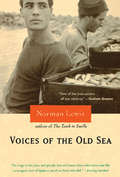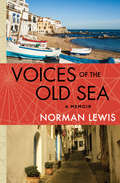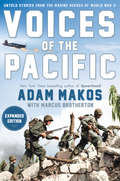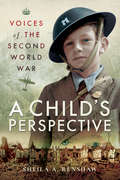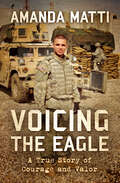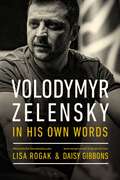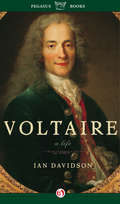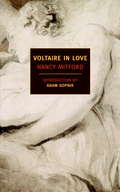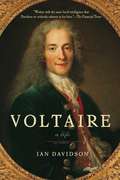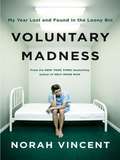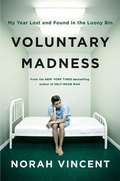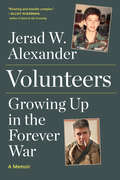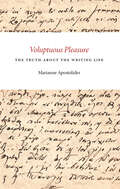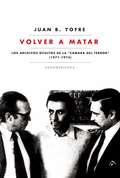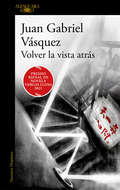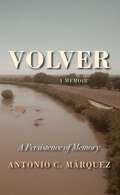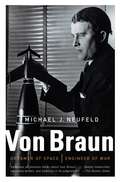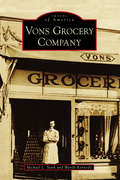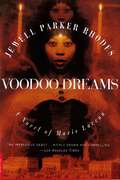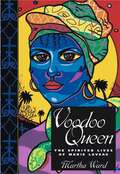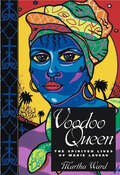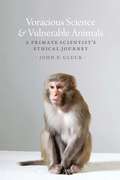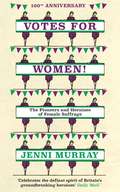- Table View
- List View
Voices of the Old Sea
by Norman LewisAfter World War II, Norman Lewis returned to Spain and settled in the remote fishing village of Farol, on what is now Costa Brava. Voices of the Old Sea describes his three successive summers in that almost medieval community where life revolved around the seasonal sardine catches, Alcade's bar, and satisfying feuds with neighboring villages. It's lucky Lewis was there when he was. Soon after, Spain was discovered by its neighbors in a more prosperous northern Europe, and the tourist tide that ensued flowed inexorably over the old ways of the town and its inhabitants.
Voices of the Old Sea (Isis Large Print Ser.)
by Norman LewisA memoir of a remote Spanish fishing village just after WWII, a community on the brink of change, by &“the finest travel writer of the last century&” (The New Yorker). Seeking solace in the everyday after his World War II army service, travel writer Norman Lewis returns to his beloved Spain, to the fishing village of Farol, in the hopes of recapturing a lost sense of home. It is a place he knows better than his native England, and he finds the Spanish countryside &“still as nostalgically backward-looking as ever, still magnificent, still invested with all its ancient virtues and ancient defects.&” He spends three seasons as a fisherman, basking in the simplicity of village customs. Lovingly written and richly evocative, Voices of the Old Sea is an absorbing look at a centuries-old lifestyle in its final days, as the tide of modernization threatens to change it forever.
Voices of the Pacific, Expanded Edition
by Adam MakosFrom the bestselling author of A Higher Call and Spearhead comes an unflinching firsthand chronicle of the heroic US Marines who fought on Guadalcanal, Peleliu, Iwo Jima, and in other pivotal battles during the Pacific War, a classic book now expanded with new stories from the flyboys overhead and the home front at war. Following fifteen Marines from Pearl Harbor, through their battles with the Japanese, to their return home after V-J Day, Adam Makos and Marcus Brotherton have compiled an oral history of the Pacific War in the words of the men who fought on the front lines. With vivid, unforgettable detail, these Marines reveal harrowing accounts of combat with an implacable enemy, the camaraderie they found, the friends they lost, and the aftermath of the war's impact on their lives. With unprecedented access to the veterans, rare photographs, and unpublished memoirs, Voices of the Pacific presents true stories of heroism as told by such World War II veterans as Sid Phillips, R.V. Burgin, and Chuck Tatum—whose exploits were featured in the classic HBO miniseries The Pacific—and their Marine buddies from the legendary 1st Marine Division.
Voices of the Second World War: A Child's Perspective
by Sheila A. RenshawVoices of the Second World War: A Childs Perspective is a collection of firsthand accounts from people who experienced the Second World War from all over Europe: stretching from Russia to the Channel Islands, and Norway to Malta.While some children appear to have been hardly aware of the war, for those who lived through bombing, occupation, deprivation, starvation and fear, the memories remain with them even today.The accounts have been relayed according to their perspective at the time and the contributors were happy to share their experiences and memories, keen in the knowledge that they were being documented as personal chroniclers of one of the twentieth century's most catastrophic events.
Voicing the Eagle: A True Story of Courage and Valor
by Amanda MattiA young Iraqi shares the true story of his wartime experiences after he was recruited by the US Army as an interpreter. Fahdi was a twenty-one-year-old, upper-middle class, English-speaking student at Baghdad University when he was recruited right off the street to serve as an interpreter for a US Army unit just days after the fall of Saddam Hussein&’s regime. Over the next two years, Fahdi would go on to translate for US drill sergeants training new Iraqi Army recruits in Ramadi; serve alongside US Marines during the first Battle of Fallujah; and eventually land a position as a linguist with Iraq&’s newly formed national intelligence agency in Baghdad. Along the way, he suffered combat injuries, faced the challenges of integrating with American soldiers in US camps, was hunted by local insurgency groups for assisting the &“infidels&”—and eventually fell in love with an American service member. As told to that service member—now his wife and the author of her own memoir, A Foreign Affair—this is a unique firsthand perspective on one of the United States&’ most controversial foreign conflicts.
Volodymyr Zelensky in His Own Words
by Lisa Rogak Daisy GibbonsAn intimate look at the awe-inspiring president of Ukraine—Volodymyr Zelensky, the new hero of the West—through an expansive book of his quotations covering his stance on a wide variety of issues, from acting and climate change to war and peace.Since Russia invaded Ukraine, people all over the world have reacted with horror and revulsion. At the same time, they have been heartened by the inspirational words and courageous actions of Volodymyr Zelensky, the 44-year-old President of Ukraine, who frequently reassures his beleaguered people while standing up to an autocratic madman who possesses the power to launch a nuclear holocaust. Zelensky is the hero we didn&’t know we needed—or maybe we did. Right now, the world wants to know more about Ukraine&’s heroic and inspiring president, and the best way to do that will be with Volodymyr Zelensky in His Own Words, an expansive book of quotations that covers Zelensky&’s words and opinions on a wide spectrum of issues—from war and peace to climate change and LGTBQ rights. Readers will be able to open up the book to any page and see where Zelensky stands. Given his previous life as a comedian and Ukraine&’s most famous actor, there are plenty of quotes that provide a more nuanced picture of this man who has enthralled and inspired people around the world.
Voltaire
by Ian DavidsonThe definitive biography of Voltaire's life--from his scandalous love affairs and political maneuverings to his inspired philosophy We think of Voltaire as the archetypal figure of the enlightenment; in his own time he was also the most famous and controversial figure in Europe. This dazzling new biography celebrates his extraordinary life. Davidson tells the whole, rich story of Voltaire's life (1694-1778): his early imprisonment in the Bastille; exile in England and his mastery of English; an obsession with money, of which he made a huge amount; a scandalous love life; a long exile on the borders of Switzerland; his human rights campaigns and his triumphant return to Paris to die there as celebrity extraordinaire. Throughout all of this, Voltaire's life was always informed by two things: a belief in the essential value of toleration in the face of fanaticism; and in the right of every man to think and say what he liked. It is rare to have such a vivid portrait of a great man.
Voltaire in Love
by Nancy Mitford Adam GopnikThe inimitable Nancy Mitford's account of Voltaire's fifteen-year relationship with the Marquise du Châtelet--the renowned mathematician who introduced Isaac Newton's revolutionary new physics to France--is a spirited romp in the company of two extraordinary individuals as well as an erudite and gossipy guide to French high society during the Enlightenment. Mitford's story is as delicious as it is complicated. The marquise was in love with another mathematician, Maupertuis, while she had an unexpected rival for Voltaire's affections in the future Frederick the Great of Prussia (and later in the philosophe's own niece). There was, at least, no jealous husband to contend with: the Marquis du Châtelet, Mitford assures us, behaved perfectly. The beau monde of Paris was, however, distraught at the idea of the lovers' brilliant conversation going to waste on the windswept hills of Champagne, site of the Château de Cirey, where experimental laboratories, a darkroom, and a library of more than twenty-one thousand volumes enabled them to pursue their amours philosophiques. From time to time the threat of impending arrest would send Voltaire scurrying across the border into Holland, but his irrepressible charm--and the interventions of powerful friends--always made it possible for him resume his studies with the cherished marquise.
Voltaire: A Life
by Ian DavidsonThe definitive biography of Voltaire's life -- from his scandalous love affairs and political maneuverings to his inspired philosophy. We think of Voltaire as the archetypal figure of the enlightenment; in his own time he was also the most famous and controversial figure in Europe. This dazzling new biography celebrates his extraordinary life. Davidson tells the whole, rich story of Voltaire's life (1694-1778): his early imprisonment in the Bastille; exile in England and his mastery of English; an obsession with money, of which he made a huge amount; a scandalous love life; a long exile on the borders of Switzerland; his human-rights campaigns and his triumphant return to Paris to die there as celebrity extraordinaire. Throughout all of this, Voltaire's life was always informed by two things: a belief in the essential value of toleration in the face of fanaticism; and in the right of every man to think and say what he liked. It is rare to have such a vivid portrait of a great man.
Voluntary Madness
by Norah VincentNorah Vincent has always suffered from depression but at the end of a book project that required her to spend eighteen months disguised as a man she felt that she was a danger to herself and was committed to a 'loony bin'. As a result of this traumatic experience Norah came out resolved to go back undercover to report on a range of mental institutions u three difficult, pressurized and very different environments u and to experience first hand their effect on the body and mind. Her journey starts in a huge inner city hospital where most patients are 'repeats', often poor and dispossessed. There Norah confronts the boredom and babbling of an underfunded facility: a place where medication is a process of containment: its purpose to make life easier for the rest of us, not the patients themselves. Cut to the calming green carpet of St Lukes: plenty of 'loonies' here too of course but Norah is taken aback when her doctor allows her to reduce her medication, have a room of her own and a regular jog in the park. Then to Mobius, and a Buddhist-inspired brand of healing, where Norah is forced to plunge deep into her emotional past, and swim through the psycho-babble to some unexpected conclusions. In Voluntary Madness, Norah Vincent takes a fearless and unprecedented view of mental health care u from the inside out. She demonstrates the power of common sense and human connection: how much better a patient can feel when treated like a person and not a petri dish. In analysing the peculiar, sometimes damaging and occasionally transformative relationships between patients and their caregivers, her consummate, fearless and darkly funny reportage makes for riveting reading.
Voluntary Madness: My Year Lost and Found in the Loony Bin
by Norah VincentThe journalist who famously lived as a man commits herself literally. Norah Vincent's New York Times bestselling book, Self-Made Man, ended on a harrowing note. Suffering from severe depression after her eighteen months living disguised as a man, Vincent felt she was a danger to herself. On the advice of her psychologist she committed herself to a mental institution. Out of this raw and overwhelming experience came the idea for her next book. She decided to get healthy and to study the effect of treatment on the depressed and insane in the bin, as she calls it. Vincent's journey takes her from a big city hospital to a facility in the Midwest and finally to an upscale retreat down south, as she analyzes the impact of institutionalization on the unwell, the tyranny of drugs-as-treatment, and the dysfunctional dynamic between caregivers and patients. Vincent applies brilliant insight as she exposes her personal struggle with depression and explores the range of people, caregivers, and methodologies that guide these strange, often scary, and bizarre environments. Eye opening, emotionally wrenching, and at times very funny, Voluntary Madness is a riveting work that exposes the state of mental health care in America from the inside out.
Volunteer Slavery: My Authentic Negro Experience
by Jill Elizabeth NelsonWhen Jill Nelson became the first black woman to write for The Washington Post's prestigious Sunday magazine in 1986, she thought she had entered journalism heaven. But the magazine proved to be insulting to black readers.
Volunteers: Growing Up in the Forever War
by Jerad W. Alexander&“Riveting and morally complex, Volunteers is not only an insider&’s account of war. It takes you inside the increasingly closed culture that creates our warriors.&” —Elliot Ackerman, author of the National Book Award finalist Dark at the Crossing As a child, Jerad Alexander lay in bed listening to the fighter jets take off outside his window and was desperate to be airborne. As a teenager at an American base in Japan, he immersed himself in war games, war movies, and pulpy novels about Vietnam. Obsessed with all things military, he grew up playing with guns, joined the Civil Air Patrol for the uniform, and reveled in the closed and safe life &“inside the castle,&” within the embrace of the armed forces, the only world he knew or could imagine. Most of all, he dreamed of enlisting—like his mother, father, stepfather, and grandfather before him—and playing his part in the Great American War Story. He joined the US Marines straight out of high school, eager for action. Once in Iraq, however, he came to realize he was fighting a lost cause, enmeshed in the ongoing War on Terror that was really just a fruitless display of American might. The myths of war, the stories of violence and masculinity and heroism, the legacy of his family—everything Alexander had planned his life around—was a mirage. Alternating scenes from childhood with skirmishes in the Iraqi desert, this original, searing, and propulsive memoir introduces a powerful new voice in the literature of war. Jerad W. Alexander—not some elite warrior, but a simple volunteer—delivers a passionate and timely reckoning with the troubled and cyclical truths of the American war machine.
Voluptuous Pleasure: The Truth About the Writing Life
by Marianne ApostolidesVoluptuous Pleasure: The Truth about the Writing Life is a collection of non-fiction whose title states that non-fiction does not exist. These stories, by acclaimed author Marianne Apostolides, are sensuous and smart, ambiguous but incisive in their truths. Voluptuous Pleasure will take you inside brothels and bedrooms, kitchens and consciousness; it will seduce you along the limits of non-fiction, making you question the veracity of anything you’ve ever read – or even experienced.
Volver a matar: Los archivos ocultos de la "Cámara del terror" (1971-1973)
by Juan B. Yofre"El setentismo es la subversión, simplemente, hay que decirlo con todaslas palabras ("). "Es querer hacer la revolución por medios violentos."Raúl R. Alfonsín (Diario Perfil, 2-IX-2007) Volver a matar es la historia de una época terrible de la RepúblicaArgentina. Narra el inicio de la "guerra popular prolongada" que lasorganizaciones terroristas declararon a todos los estamentos del EstadoNacional, bajo la inspiración del castro-comunismo. Pero el libro seocupa, fundamentalmente, de la forma en que el Estado argentino lascombatió con la ley en la mano a partir de julio de 1971, cuando creó laCámara Federal en lo Penal de la Nación. El tiempo de esta Cámara "a laque la subversión llamó despectivamente "Camarón" o "Cámara del terror"fue muy corto, duró hasta el 25 de mayo de 1973, día en que conviolencia se abrieron las rejas de las cárceles y los presos volvieron asus organizaciones clandestinas para sembrar la muerte, aún en una épocade gobierno constitucional.Por primera vez el lector conocerá algunos de los numerosos casos quetrató el alto tribunal, compuesto por jurisconsultos de largatrayectoria. Ellos triunfaron pero también perdieron. Impusieron la ley,no hubo represión ilegal, pero luego, con el gobierno de Héctor J.Cámpora, fueron perseguidos, degradados, sufrieron atentados o tuvieronque exiliarse.Tras la ley de amnistía "amplia y generosa", José Alberto Deheza, exministro de Justicia y de Defensa de Isabel Martínez de Perón, declaró:"No soy contrario a la ley del olvido, pero una ley que libera a simplesasesinos que sembraron el terror matando a mansalva en nombre de idealesrevolucionarios, importa una grave irresponsabilidad. En la mayor partede los casos, se trataba de componentes de bandas clandestinas queemboscaban a sus víctimas para ultimarlas con perversidad".Volver a matar se sumerge en un archivo secreto que muchos intentarondestruir, pero que fue salvado para las generaciones futuras.Testimonios inéditos y documentos confidenciales desconocidos hasta hoyabonan lo afirmado. Una vez más, como lo hiciera en "Nadie fue" y en"Fuimos todos", Juan B. Yofre brinda aquí un aporte fundamental anuestra historia reciente y rinde su homenaje a la memoria completa delos argentinos.
Volver la vista atrás
by Juan Gabriel VásquezEl nuevo libro del premio Alfaguara de novela: un relato «sin ficción» sobre las relaciones entre padres e hijos marcadas por las ideas políticas y el fanatismo. «Pensó que los recuerdos eran invisibles como la luz, y así como el humo hacía que la luz se viera, debía haber una forma de que fueran visibles los recuerdos.» En octubre de 2016, el director de cine colombiano Sergio Cabrera asiste en Barcelona a una retrospectiva de sus películas. Es un momento difícil: su padre, Fausto Cabrera, acaba de morir; su matrimonio está en crisis, y su país ha rechazado unos acuerdos de paz que le habrían permitido terminar con más de cincuenta años de guerra. A lo largo de unos días reveladores, Sergio irá recordando los hechos que marcaron su vida y la de su padre. De la guerra civil española al exilio en América de su familia republicana, de la China de la Revolución Cultural a los movimientos armados de los años sesenta, el lector asistirá a una vida que es mucho más que una gran aventura: es una imagen de medio siglo de historia que trastornó al mundo entero. Volver la vista atrás cuenta hechos reales, pero sólo en manos de un novelista magistral como Vásquez podía convertirse en este retrato devastador de una familia arrastrada por las fuerzas de la historia. Una fascinante investigación social y a la vez íntima, política y a la vez privada, que el lector no olvidará. La crítica ha dicho:«Una novela maravillosa, muy contundente. Sentí que estaba leyendo un clásico. Juan Gabriel Vásquez es uno de los mejores escritores de habla hispana.»Leila Guerriero «Una de las voces más originales de la nueva literatura latinoamericana.»Mario Vargas Llosa «Volver la vista atrás está escrito con una envidiable plenitud de estilo y un portentoso control de la dosificación de impulsos novelísticos.»Sergi Pàmies, La Vanguardia «Una lúcida y sutil metáfora de cómo las ideologías marcaron las vidas privadas del siglo XX.»Andrés Seoane, El Cultural «Vásquez ha sucedido a García Márquez como el gran maestro literario de Colombia.»Ariel Dorfman, The New York Review of Books «Un magnífico y aterrador estudio sobre cómo el pasado puede invadir el presente, y una fascinante revelación de un rincón poco conocido del teatro de la guerra nazi.»John Banville (sobre Los informantes) «Un libro vívido, contundente, magistral.»Alberto Manguel, The Guardian (sobre Historia secreta de Costaguana) «Una novela cautivadora, que atrapa hasta el final. Si bien estamos ante un “vuelapáginas”, se trata también de una profunda meditación sobre el destino y la muerte.»Edmund White, The New York Times Book Review (sobre El ruido de las cosas al caer) «Uno sale de esta novela simplemente aturdido por la gran lección de literatura impartida por el autor.»Étienne de Montety, Le Figaro (sobre Las reputaciones) «Un gran libro [...] A ratos se lee como un thriller político. Es su obra más ambiciosa y la mejor hasta el momento.»Daniel Hahn, Prospect Magazine (sobre La forma de las ruinas) «Magnífico libro [...] Coherente, vertebrado, casi perfecto.»Nadal Suau, El Cultural (sobre Canciones para el incendio)
Volver: A Persistence of Memory
by Antonio C. MárquezBorn on the eve of World War II into a family of Mexican immigrants in El Paso, Antonio C. Márquez remains a child of the border, his life partaking of multiple cultures, countries, and classes. Here he recounts his life story, from childhood memories of movies and baseball and friendship with his Chinese Mexican American neighbor, Manuel Wong, to the turbulent events of his manhood. Márquez recalls the impact of immigration and war on his family; his experiences of gang conflict in El Paso and Los Angeles in the 1960s; enlisting in the Marine Corps; his activism in the civil rights movement, the antiwar movement of the Vietnam era, and the Crusade for Justice; and his travels to crisis-ridden Latin American countries. From a family where no one had the luxury of higher education, Márquez became a professor when universities hired few Chicanos. His is a story of survival and courage.
Von Braun: Dreamer of Space, Engineer of War
by Michael NeufeldCurator and space historian at the Smithsonian's National Air and Space Museum delivers a brilliantly nuanced biography of controversial space pioneer Wernher von Braun. Chief rocket engineer of the Third Reich and one of the fathers of the U.S. space program, Wernher von Braun is a source of consistent fascination. Glorified as a visionary and vilified as a war criminal, he was a man of profound moral complexities, whose intelligence and charisma were coupled with an enormous and, some would say, blinding ambition. Based on new sources, Neufeld's biography delivers a meticulously researched and authoritative portrait of the creator of the V-2 rocket and his times, detailing how he was a man caught between morality and progress, between his dreams of the heavens and the earthbound realities of his life.
Von Neumann, Morgenstern, and the Creation of Game Theory
by Robert LeonardDrawing on a wealth of new archival material, including personal correspondence and diaries, Robert Leonard tells the fascinating story of the creation of game theory by Hungarian Jewish mathematician John von Neumann and Austrian economist Oskar Morgenstern. Game theory first emerged amid discussions of the psychology and mathematics of chess in Germany and fin-de-sicle Austro-Hungary. In the 1930s, on the cusp of anti-Semitism and political upheaval, it was developed by von Neumann into an ambitious theory of social organization. It was shaped still further by its use in combat analysis in World War II and during the Cold War. Interweaving accounts of the period's economics, science, and mathematics, and drawing sensitively on the private lives of von Neumann and Morgenstern, Robert Leonard provides a detailed reconstruction of a complex historical drama.
Vons Grocery Company (Images of America)
by Michael L. Stark Wendy KennedyIn 1906, the downtown area of Los Angeles was fundamentally a small town when Charles Von der Ahe opened his little Groceteria on the corner of Seventh and Figueroa Streets using $1,200 in savings. It was a neighborhood store that catered to the needs of local families, where Von der Ahe pioneered "cash and carry," replacing the "charge and delivery" way of thinking. Its expansion and innovation over the next 90 years was legendary, growing to more than 325 stores and 30,000 employees. This book focuses on the legacy of this great company, its visionary leaders, and its dedicated employees who made it the number one grocery retailer in Southern California.
Voodoo Dreams: A Novel of Marie Laveau
by Jewell Parker RhodesNew Orleans in the mid-nineteenth century: a potent mix of whites, Creoles, free blacks, and African slaves, a city pulsing with crowds, commerce, and an undercurrent of secret power. The source of this power is the voodoo religion, and its queen is Marie Laveau, the notorious voodooienne, worshipped and feared by blacks and whites alike. A mesmerizing combination of history, oral tradition, and storytelling, Voodoo Dreams reimagines the woman behind an enduring American legend. Jewell Parker Rhodes's novel is a memorable, magical debut.
Voodoo Queen: The Spirited Lives of Marie Laveau
by Martha WardEach year, thousands of pilgrims visit the tomb of Marie Laveau in New Orleans. In this old city she and her curse long have ruled the imagination. She has been conjured in dance, drumming, song, and necromancy. With dread and fierce affection, her celebrants ask for her favors and fearfully revere her enduring authority as "the Voodoo Queen." Who was Marie Laveau? This book about her mysterious life, magical deeds, and pervasive power recounts that there were two historical figures by this name, a mother and a daughter. They were free women of color, prominent French-speaking Catholic Creoles, and legendary leaders of a religious and spiritual tradition that orthodox faiths label as evil. From the 1820s until the 1880s, when one Marie died and the other disappeared, a mixture of gossip and devotion swirled about them.
Voodoo Queen: The Spirited Lives of Marie Laveau
by Martha WardEach year, thousands of pilgrims visit the celebrated New Orleans tomb where Marie Laveau is said to lie. They seek her favors or fear her lingering influence. Voodoo Queen: The Spirited Lives of Marie Laveau is the first study of the Laveaus, mother and daughter of the same name. Both were legendary leaders of religious and spiritual traditions many still label as evil. The Laveaus were free women of color and prominent French-speaking Catholic Creoles. From the 1820s until the 1880s when one died and the other disappeared, gossip, fear, and fierce affection swirled about them. From the heart of the French Quarter, in dance, drumming, song, and spirit possession, they ruled the imagination of New Orleans. How did the two Maries apply their “magical” powers and uncommon business sense to shift the course of love, luck, and the law? The women understood the real crime—they had pitted their spiritual forces against the slave system of the United States. Moses-like, they led their people out of bondage and offered protection and freedom to the community of color, rich white women, enslaved families, and men condemned to hang. The curse of the Laveau family, however, followed them. Both loved men they could never marry. Both faced down the press and police who stalked them. Both countered the relentless gossip of curses, evil spirits, murders, and infant sacrifice with acts of benevolence. The book is also a detective story—who is really buried in the famous tomb in the oldest “city of the dead” in New Orleans? What scandals did the Laveau family intend to keep buried there forever? By what sleight of hand did free people of color lose their cultural identity when Americans purchased Louisiana and imposed racial apartheid upon Creole creativity? Voodoo Queen brings the improbable testimonies of saints, spirits, and never-before-printed eyewitness accounts of ceremonies and magical crafts together to illuminate the lives of the two Marie Laveaus, leaders of a major, indigenous American religion.
Voracious Science & Vulnerable Animals: A Primate Scientist's Ethical Journey (Animal Lives Ser.)
by John P. GluckThe National Institute of Health recently announced its plan to retire the fifty remaining chimpanzees held in national research facilities and place them in sanctuaries. This significant decision comes after a lengthy process of examination and debate about the ethics of animal research. For decades, proponents of such research have argued that the discoveries and benefits for humans far outweigh the costs of the traumatic effects on the animals; but today, even the researchers themselves have come to question the practice. John P. Gluck has been one of the scientists at the forefront of the movement to end research on primates, and in Voracious Science and Vulnerable Animals he tells a vivid, heart-rending, personal story of how he became a vocal activist for animal protection. Gluck begins by taking us inside the laboratory of Harry F. Harlow at the University of Wisconsin, where Gluck worked as a graduate student in the 1960s. Harlow’s primate lab became famous for his behavioral experiments in maternal deprivation and social isolation of rhesus macaques. Though trained as a behavioral scientist, Gluck finds himself unable to overlook the intense psychological and physical damage these experiments wrought on the macaques. Gluck’s sobering and moving account reveals how in this and other labs, including his own, he came to grapple with the uncomfortable justifications that many researchers were offering for their work. As his sense of conflict grows, we’re right alongside him, developing a deep empathy for the often smart and always vulnerable animals used for these experiments. At a time of unprecedented recognition of the intellectual cognition and emotional intelligence of animals, Voracious Science and Vulnerable Animals is a powerful appeal for our respect and compassion for those creatures who have unwillingly dedicated their lives to science. Through the words of someone who has inflicted pain in the name of science and come to abhor it, it’s important to know what has led this far to progress and where further inroads in animal research ethics are needed.
Votes For Women!: The Pioneers and Heroines of Female Suffrage (from the pages of A History of Britain in 21 Women)
by Jenni MurrayMary Wollstonecraft, Elizabeth Garrett Anderson, Millicent Fawcett, Emmeline Pankhurst, Constance Markievicz, Nancy Astor They terrorised the establishment. They fought for the vote. They pushed back boundaries and revolutionised our world. For the hundredth anniversary of the historic moment the franchise was finally extended to women, here is a selection of suffragette and suffragist activists and pioneering MPs from the pages of Jenni Murray&’s bestselling A History of Britain in 21 Women. Set against the backdrop of a world where equality is still to be achieved, it is a vital reminder of the great women who fought for change.
